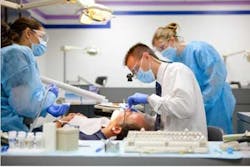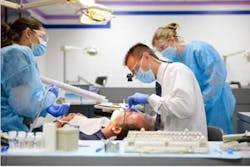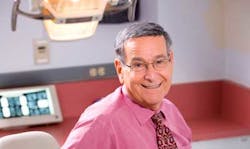Study shows nasal spray anesthesia may work as well as injections for dental procedures
One of the most dreaded experiences at the dentist’s office is an injection into the tissues of the mouth to numb an area requiring a painful dental procedure. But thanks to recent research at the University at Buffalo School of Dental Medicine, these injections may be a thing of the past — at least for some procedures.RELATED |Needle-free anesthetics hitting the dental scene Sebastian G. Ciancio, DDS, UB Distinguished Service Professor, chair of periodontics and endodontics, director of the Center of Dental Studies and his research team recently published the results of a study in the Journal of Dental Research examining the effectiveness, safety, and tolerability of nasal anesthesia spray to produce numbness of maxillary teeth (the upper teeth). The study was approved for Food and Drug Administration (FDA) Phase 2 protocol.
According to Ciancio, dentists have several concerns when administering injectable anesthesia that include but are not limited to the patient’s concern with the needle stick.RELATED |A dentist’s discovery of anesthesia shaped the future of medicine “Injection carries several disadvantages. The most obvious is the patient’s fear of pain. But injections also carry the possibility of exposure to blood-borne pathogens via needle stick; the risk that the anesthesia may not be effective; and injury or tenderness after the procedure,” says Ciancio.
Sebastian G. Ciancio, DDS Ciancio’s research team studied 45 adults with a mean age of 39 requiring the filling of one upper tooth. Some patients were given an intraoral lidocaine-epinepherine (anesthetic) injection with buffered nasal spray bilaterally, and some were given an active anesthetic nasal spray with “sham” injection. “We constantly monitored our patients for pain and were prepared to give ‘rescue’ anesthesia to the patients with the ‘sham’ injection who needed it,” says Ciancio. It turned out that 25 of 30 patients – or 83.3% – required no rescue anesthesia. Ciancio says the results indicate that the nasal spray provided sufficient anesthesia for the performance of restorative dental procedures in most patients, and that it meets the FDA standard for being better than a placebo. A separate study involving children is nearing completion, says Ciancio, and a wide age range of adults have been included in Phase 3 studies, which may provide valuable age-related information.The University at Buffalo is a premier research-intensive public university, the largest and most comprehensive campus in the State University of New York. UB's more than 28,000 students pursue their academic interests through more than 300 undergraduate, graduate, and professional degree programs. Founded in 1846, the University at Buffalo is a member of the Association of American Universities.


